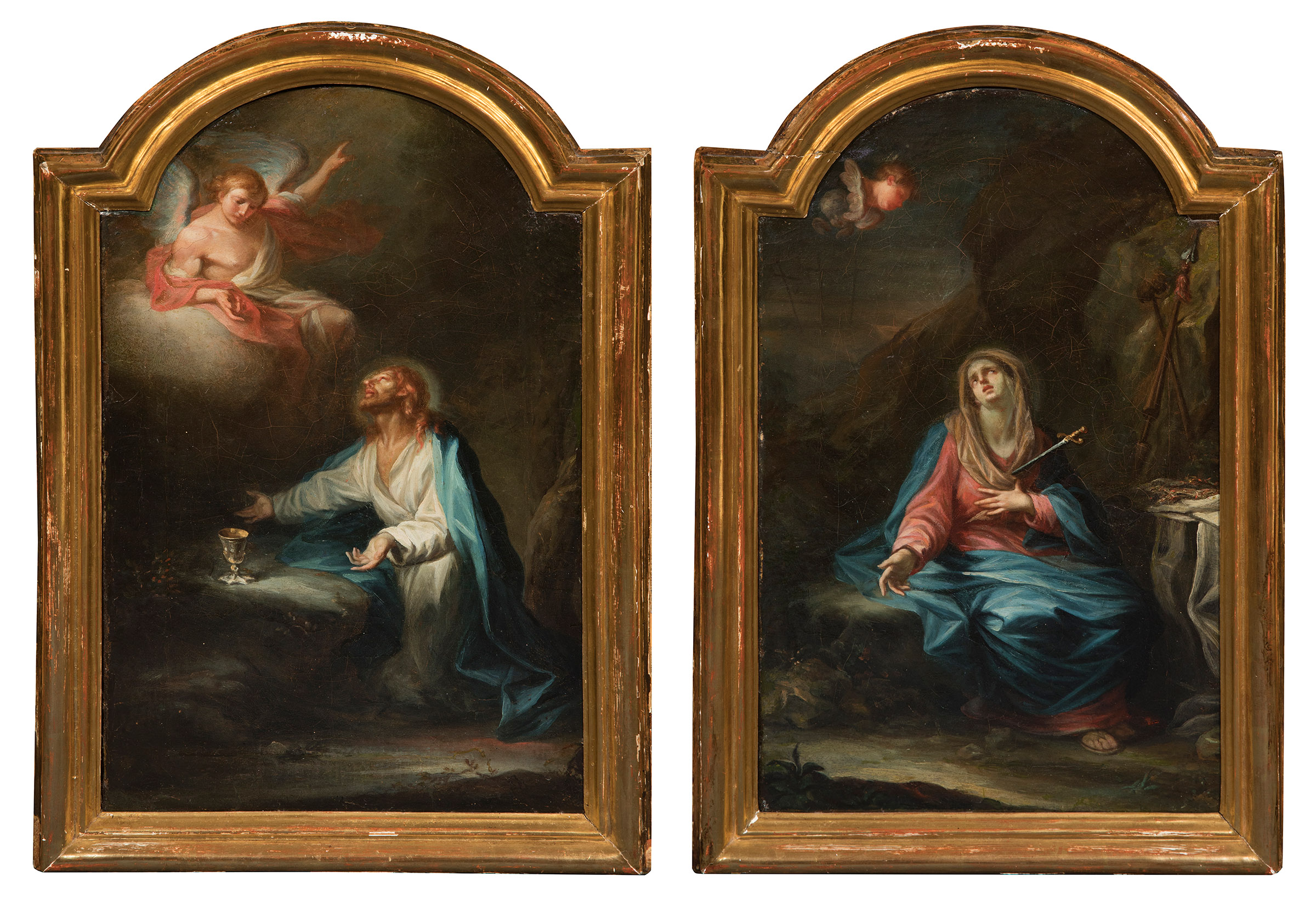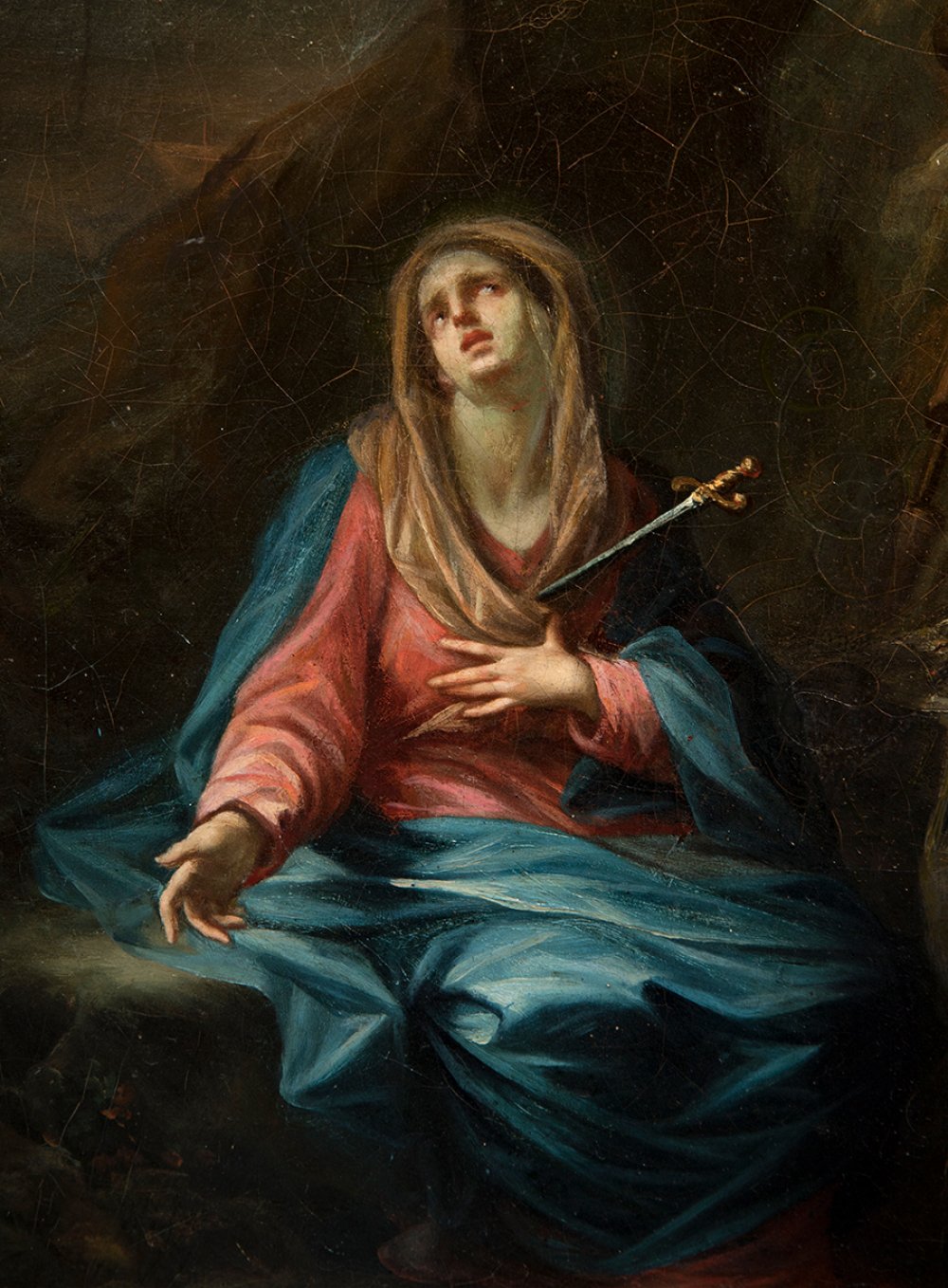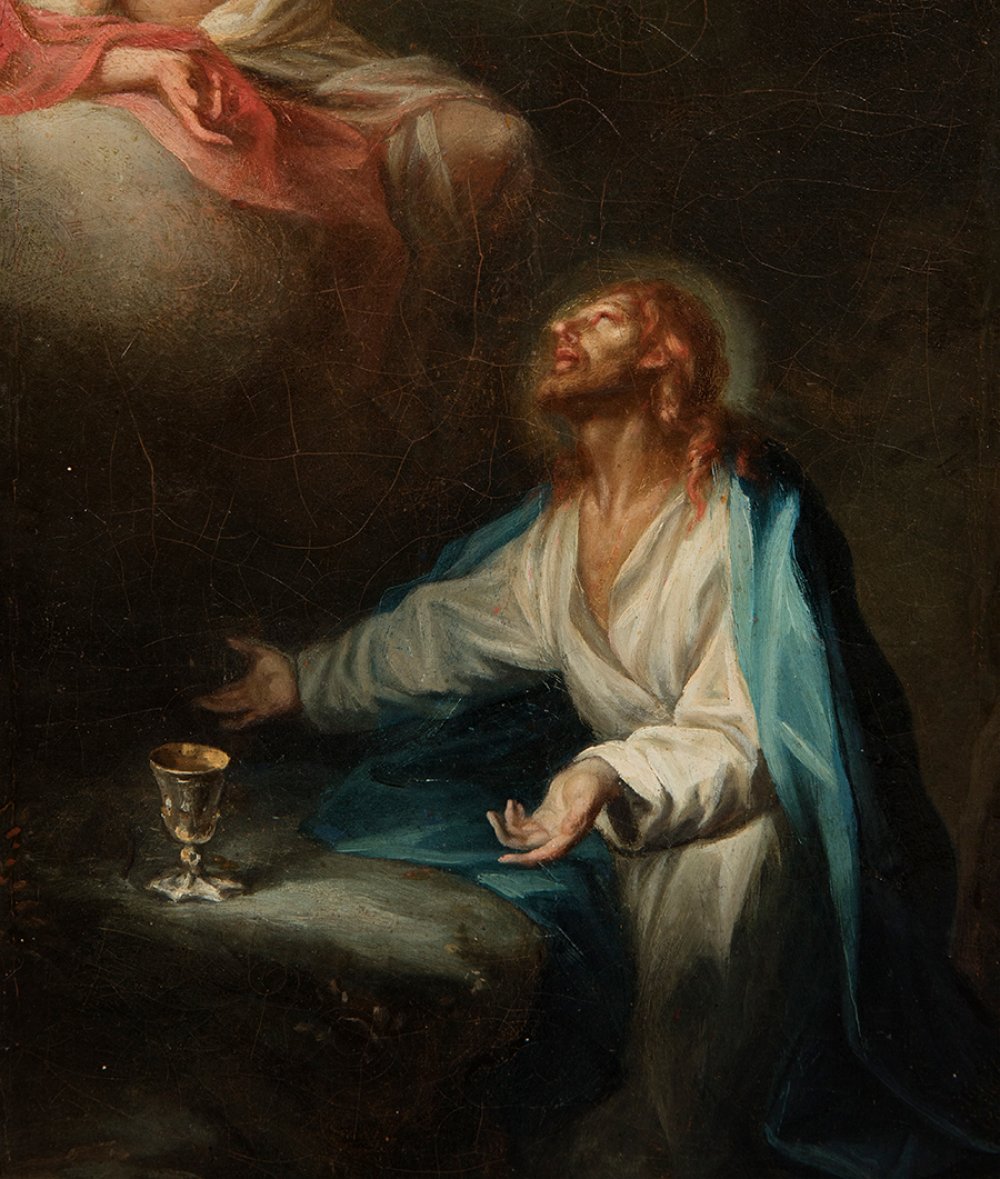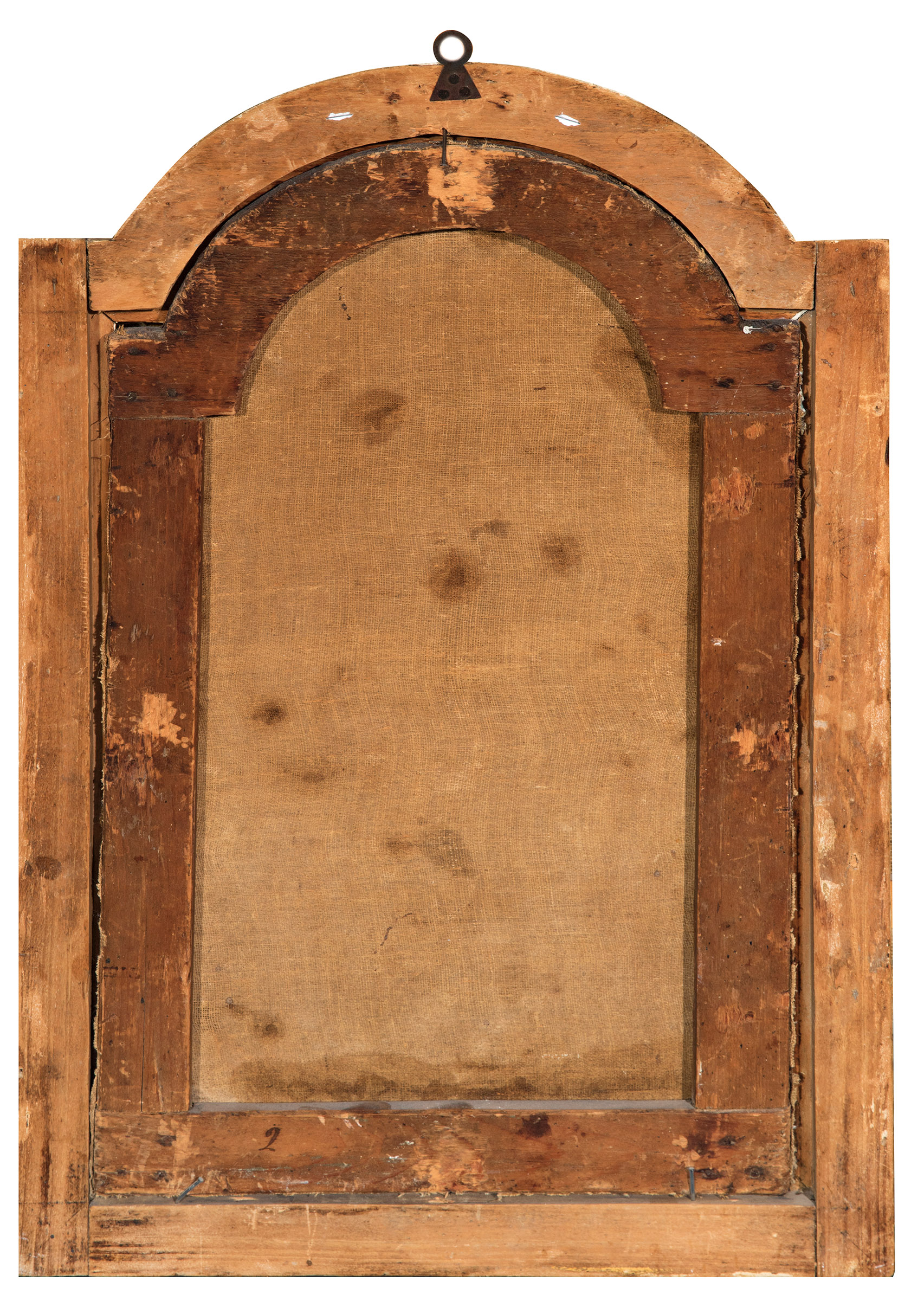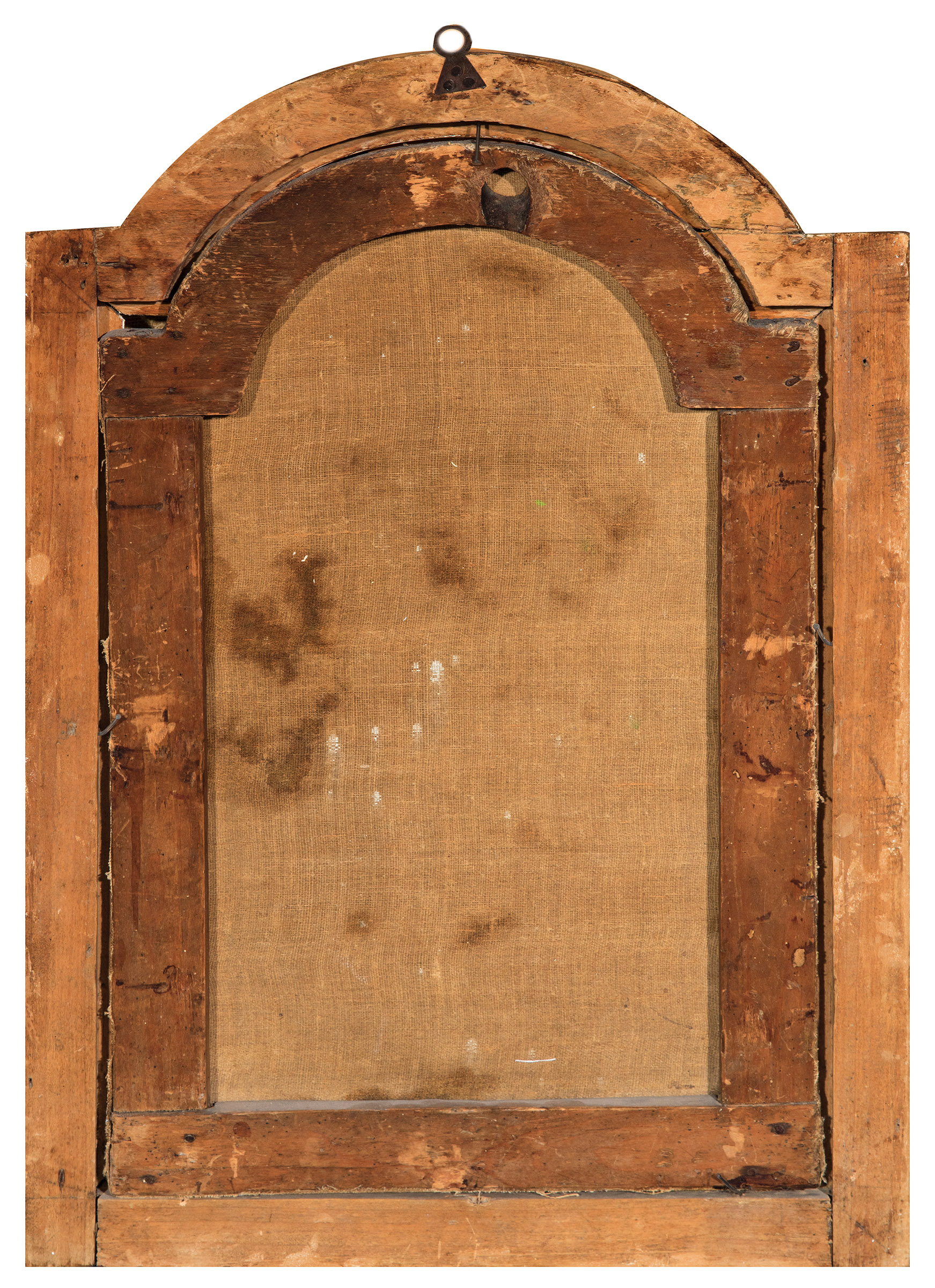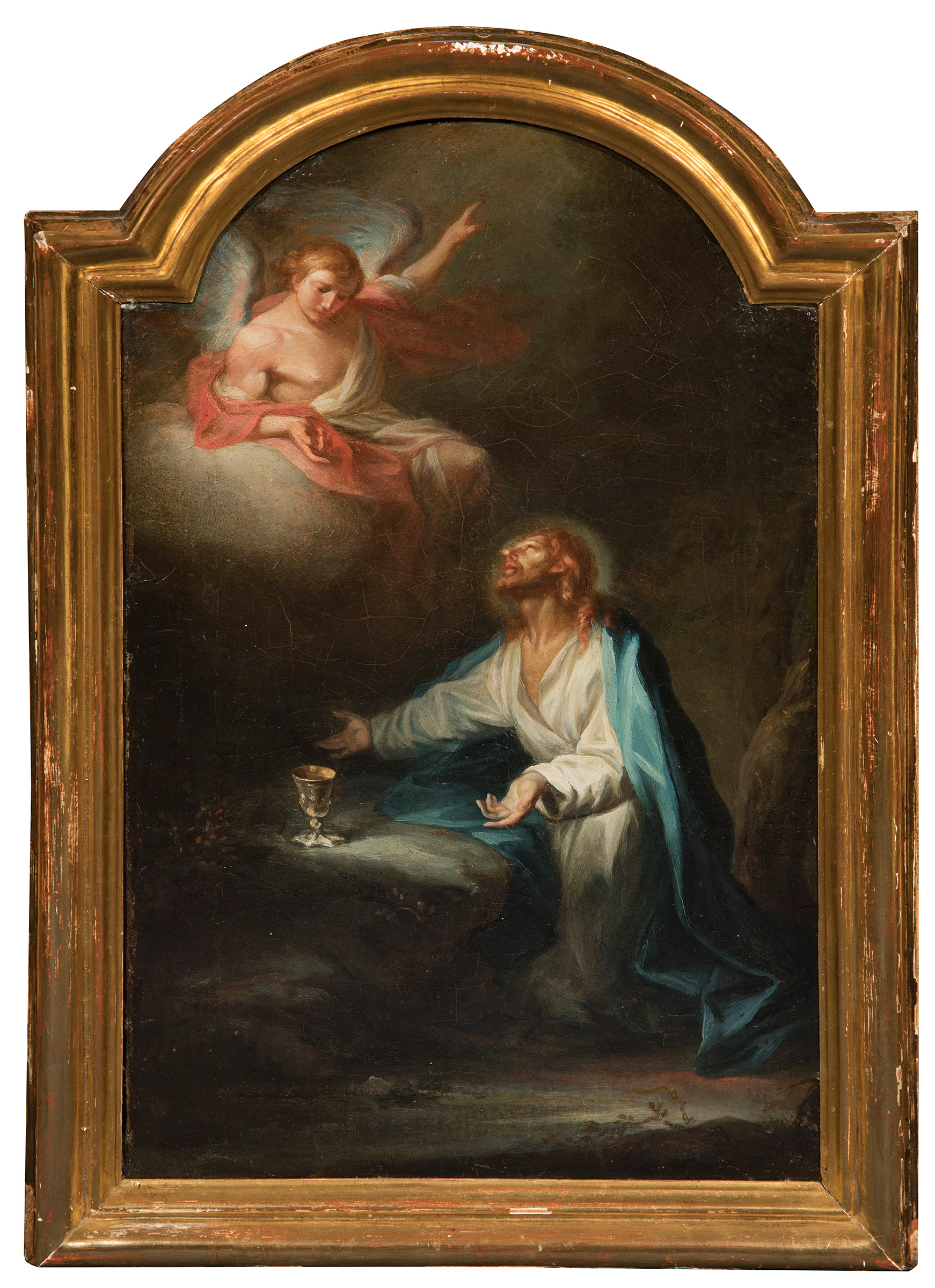8
Circle of FRANCISCO DE GOYA Y LUCIENTES (Fuendetodos, Zaragoza, 1746 - Bordeaux, France, 1828),"
1/7
Description
Circle of FRANCISCO DE GOYA Y LUCIENTES (Fuendetodos, Zaragoza, 1746 - Bordeaux, France, 1828),
"Prayer in the Garden, c. 1790.
Oil on canvas.
Original period frame preserved.
Size: 46,5 x 28 cm (x2); 53,5 x 35,5 cm (frame, x2).
Pair of devotional canvases, which due to their size and format may have been part of a larger ornamental ensemble. Although both are depicted with different figures, one with the Virgin as the Sorrowful Virgin and the other with the figure of Christ in the Garden of Olives, both works are very similar in terms of composition. In both paintings, the main figure is in the centre of the scene, set in a rocky but somewhat indeterminate landscape, and the two figures look towards the sky, leaning to the right to observe an angel in both cases. Furthermore, the colours in the two paintings are very similar, both in the depiction of the landscape constructed using dark tones and in the blue of the cloaks and the pink of the Virgin's tunic, which is the colour used for the angel's tunic. The Gospels narrate that, distressed by a strange sadness, Jesus went to pray on the Mount of Olives, where the apostles followed him. Once there, Jesus withdrew to one side to pray, the moment of the crucifixion becoming clear to him. Jesus knelt down and prayed, saying: "Father, if you are willing, take this cup from me; yet not my will, but yours be done". Thus, this episode begins the bloody Passion in the soul of Christ. The apostles fall into a deep sleep, and an angel appears to Jesus to comfort him. And in agony, he persisted in his prayer. His sweat became like thick drops of blood falling to the ground. Rising from prayer, he came to the disciples and found them asleep with sorrow; and he said to them, "How is it that you are asleep? Rise and pray that you may not fall into temptation". In fact, this episode alludes to the greatest temptation of Jesus' life, the last of them all: knowing his destiny, he can either flee from his enemies or continue to fulfil his divine mission, risking his life.
By 1790 Goya enjoyed a privileged position at the Spanish court, and his works for the Royal Tapestry Factory of Santa Barbara were admired and recognised by the painters of the capital. It is in this context that the present work is set, reflecting the influence that Goya's tapestry cartoons exerted on his contemporaries. Although it is unusual in the master's works, the present work depicts a scene of a religious nature. From the reign of Charles III onwards, painters strove to depict typically Spanish motifs, in line with the picturesque style of Ramón de la Cruz's theatrical sainetes and the popular prints by Juan de la Cruz Cano y Olmedilla. In formal terms, however, Goya's influence is direct; having abandoned strict classicism and rigorous draftsmanship, works such as this one develop a strictly modern language of loose, uncluttered execution, with the painters focusing not only on description but above all on capturing atmospheric, luminous and chromatic impressions.
"Prayer in the Garden, c. 1790.
Oil on canvas.
Original period frame preserved.
Size: 46,5 x 28 cm (x2); 53,5 x 35,5 cm (frame, x2).
Pair of devotional canvases, which due to their size and format may have been part of a larger ornamental ensemble. Although both are depicted with different figures, one with the Virgin as the Sorrowful Virgin and the other with the figure of Christ in the Garden of Olives, both works are very similar in terms of composition. In both paintings, the main figure is in the centre of the scene, set in a rocky but somewhat indeterminate landscape, and the two figures look towards the sky, leaning to the right to observe an angel in both cases. Furthermore, the colours in the two paintings are very similar, both in the depiction of the landscape constructed using dark tones and in the blue of the cloaks and the pink of the Virgin's tunic, which is the colour used for the angel's tunic. The Gospels narrate that, distressed by a strange sadness, Jesus went to pray on the Mount of Olives, where the apostles followed him. Once there, Jesus withdrew to one side to pray, the moment of the crucifixion becoming clear to him. Jesus knelt down and prayed, saying: "Father, if you are willing, take this cup from me; yet not my will, but yours be done". Thus, this episode begins the bloody Passion in the soul of Christ. The apostles fall into a deep sleep, and an angel appears to Jesus to comfort him. And in agony, he persisted in his prayer. His sweat became like thick drops of blood falling to the ground. Rising from prayer, he came to the disciples and found them asleep with sorrow; and he said to them, "How is it that you are asleep? Rise and pray that you may not fall into temptation". In fact, this episode alludes to the greatest temptation of Jesus' life, the last of them all: knowing his destiny, he can either flee from his enemies or continue to fulfil his divine mission, risking his life.
By 1790 Goya enjoyed a privileged position at the Spanish court, and his works for the Royal Tapestry Factory of Santa Barbara were admired and recognised by the painters of the capital. It is in this context that the present work is set, reflecting the influence that Goya's tapestry cartoons exerted on his contemporaries. Although it is unusual in the master's works, the present work depicts a scene of a religious nature. From the reign of Charles III onwards, painters strove to depict typically Spanish motifs, in line with the picturesque style of Ramón de la Cruz's theatrical sainetes and the popular prints by Juan de la Cruz Cano y Olmedilla. In formal terms, however, Goya's influence is direct; having abandoned strict classicism and rigorous draftsmanship, works such as this one develop a strictly modern language of loose, uncluttered execution, with the painters focusing not only on description but above all on capturing atmospheric, luminous and chromatic impressions.
Auction Details
Shipping
T&Cs & Important Info
Ask seller a question
Circle of FRANCISCO DE GOYA Y LUCIENTES (Fuendetodos, Zaragoza, 1746 - Bordeaux, France, 1828),
"Prayer in the Garden, c. 1790.
Oil on canvas.
Original period frame preserved.
Size: 46,5 x 28 cm (x2); 53,5 x 35,5 cm (frame, x2).
Pair of devotional canvases, which due to their size and format may have been part of a larger ornamental ensemble. Although both are depicted with different figures, one with the Virgin as the Sorrowful Virgin and the other with the figure of Christ in the Garden of Olives, both works are very similar in terms of composition. In both paintings, the main figure is in the centre of the scene, set in a rocky but somewhat indeterminate landscape, and the two figures look towards the sky, leaning to the right to observe an angel in both cases. Furthermore, the colours in the two paintings are very similar, both in the depiction of the landscape constructed using dark tones and in the blue of the cloaks and the pink of the Virgin's tunic, which is the colour used for the angel's tunic. The Gospels narrate that, distressed by a strange sadness, Jesus went to pray on the Mount of Olives, where the apostles followed him. Once there, Jesus withdrew to one side to pray, the moment of the crucifixion becoming clear to him. Jesus knelt down and prayed, saying: "Father, if you are willing, take this cup from me; yet not my will, but yours be done". Thus, this episode begins the bloody Passion in the soul of Christ. The apostles fall into a deep sleep, and an angel appears to Jesus to comfort him. And in agony, he persisted in his prayer. His sweat became like thick drops of blood falling to the ground. Rising from prayer, he came to the disciples and found them asleep with sorrow; and he said to them, "How is it that you are asleep? Rise and pray that you may not fall into temptation". In fact, this episode alludes to the greatest temptation of Jesus' life, the last of them all: knowing his destiny, he can either flee from his enemies or continue to fulfil his divine mission, risking his life.
By 1790 Goya enjoyed a privileged position at the Spanish court, and his works for the Royal Tapestry Factory of Santa Barbara were admired and recognised by the painters of the capital. It is in this context that the present work is set, reflecting the influence that Goya's tapestry cartoons exerted on his contemporaries. Although it is unusual in the master's works, the present work depicts a scene of a religious nature. From the reign of Charles III onwards, painters strove to depict typically Spanish motifs, in line with the picturesque style of Ramón de la Cruz's theatrical sainetes and the popular prints by Juan de la Cruz Cano y Olmedilla. In formal terms, however, Goya's influence is direct; having abandoned strict classicism and rigorous draftsmanship, works such as this one develop a strictly modern language of loose, uncluttered execution, with the painters focusing not only on description but above all on capturing atmospheric, luminous and chromatic impressions.
"Prayer in the Garden, c. 1790.
Oil on canvas.
Original period frame preserved.
Size: 46,5 x 28 cm (x2); 53,5 x 35,5 cm (frame, x2).
Pair of devotional canvases, which due to their size and format may have been part of a larger ornamental ensemble. Although both are depicted with different figures, one with the Virgin as the Sorrowful Virgin and the other with the figure of Christ in the Garden of Olives, both works are very similar in terms of composition. In both paintings, the main figure is in the centre of the scene, set in a rocky but somewhat indeterminate landscape, and the two figures look towards the sky, leaning to the right to observe an angel in both cases. Furthermore, the colours in the two paintings are very similar, both in the depiction of the landscape constructed using dark tones and in the blue of the cloaks and the pink of the Virgin's tunic, which is the colour used for the angel's tunic. The Gospels narrate that, distressed by a strange sadness, Jesus went to pray on the Mount of Olives, where the apostles followed him. Once there, Jesus withdrew to one side to pray, the moment of the crucifixion becoming clear to him. Jesus knelt down and prayed, saying: "Father, if you are willing, take this cup from me; yet not my will, but yours be done". Thus, this episode begins the bloody Passion in the soul of Christ. The apostles fall into a deep sleep, and an angel appears to Jesus to comfort him. And in agony, he persisted in his prayer. His sweat became like thick drops of blood falling to the ground. Rising from prayer, he came to the disciples and found them asleep with sorrow; and he said to them, "How is it that you are asleep? Rise and pray that you may not fall into temptation". In fact, this episode alludes to the greatest temptation of Jesus' life, the last of them all: knowing his destiny, he can either flee from his enemies or continue to fulfil his divine mission, risking his life.
By 1790 Goya enjoyed a privileged position at the Spanish court, and his works for the Royal Tapestry Factory of Santa Barbara were admired and recognised by the painters of the capital. It is in this context that the present work is set, reflecting the influence that Goya's tapestry cartoons exerted on his contemporaries. Although it is unusual in the master's works, the present work depicts a scene of a religious nature. From the reign of Charles III onwards, painters strove to depict typically Spanish motifs, in line with the picturesque style of Ramón de la Cruz's theatrical sainetes and the popular prints by Juan de la Cruz Cano y Olmedilla. In formal terms, however, Goya's influence is direct; having abandoned strict classicism and rigorous draftsmanship, works such as this one develop a strictly modern language of loose, uncluttered execution, with the painters focusing not only on description but above all on capturing atmospheric, luminous and chromatic impressions.
29th December - Old Masters
Sale Date(s)
Venue Address
Aragón 346, Barcelona
Calle Velázquez 7, Madrid
Carrer de Cirilo Amorós 55, Valencia
Barcelona
08009
Spain
General delivery information available from the auctioneer
Setdart offers Worldwide shipping
PICK UP IN ROOM: You can come and pick up your lots in our offices (Barcelona, Madrid or Valencia). At the moment of the withdrawal, you will be able to accept the current conditions of the lot by means of a document that you will sign.
YOU CAN SEND ANOTHER PERSON TO PICK UP: This person must present a signed authorization that you can find in our web page by accessing from BUY AT SETDART- LOGISTICS-DOWNLOAD AUTHORIZATION DOCUMENT. You can also send an e-mail with the requested data in AUTHORIZATION DOCUMENT to admin@setdart.com
Important Information
25% buyer´s premium
21% buyer´s premium at www.setdart.com















